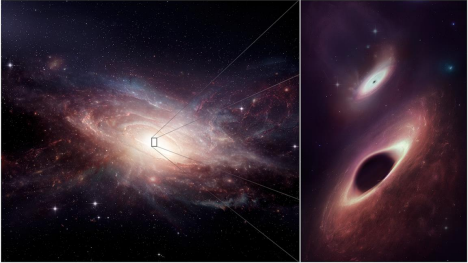Scientists find 2 giant black holes ‘dining together’ using Maunakea observatory data
While studying a nearby pair of merging galaxies using data from the W.M. Keck Observatory on Maunakea, scientists discovered two supermassive black holes growing simultaneously near the center of the newly coalescing galaxy, dubbed UGC 4211.
A black hole is a place in space where gravity pulls so much that even light can not get out. These two super-hungry black holes — which are gluttonously devouring the dust, gas and other byproducts of the merger — are the closest together that scientists have ever observed in multiple wavelengths.
What’s more, the new research reveals that binary black holes and the galaxy mergers that create them may be surprisingly common in the universe.
The study is published in the Jan. 9, 2023 issue of The Astrophysical Journal Letters and presented in a press conference at the 241st meeting of the American Astronomical Society in Seattle, Wash.

At just 500 million light-years away from Earth in the constellation Cancer, UGC 4211 is an ideal candidate for studying the end stages of galaxy mergers, which occur more frequently in the distant universe, and as a result, can be difficult to observe.
When scientists looked deep into the merger’s active galactic nuclei — compact, highly luminous areas in galaxies caused by the accumulation of matter around central black holes — they found not one but two hungry black holes. Surprisingly, they were dining side-by-side with just 750 light-years between them.
“Simulations suggested that most of the population of black hole binaries in nearby galaxies would be inactive because they are more common, not two growing black holes like we found,” said Michael Koss, a senior research scientist at Eureka Scientific and the lead author of the study.
If close-paired binary black hole pairs are indeed common, as Koss and the team assume, there could be significant implications for future detections of gravitational waves.
Ezequiel Treister, an astronomer at Universidad Católica de Chile and a co-author of the research, said: “There might be many pairs of growing supermassive black holes in the centers of galaxies that we have not been able to identify so far. If this is the case, in the near future we will be observing frequent gravitational wave events caused by the mergers of these objects across the universe.”
The team observed UGC 4211 in multiple wavelengths using various telescopes around the world and in space. In addition to using Keck Observatory’s adaptive optics system paired with its Near-Infrared Camera, second generation (NIRC2) and OH-Suppressing Infrared Imaging Spectrograph (OSIRIS), the researchers also studied the galaxy merger with the Hubble Space Telescope, European Southern Observatory’s Very Large Telescope, Atacama Large Millimeter/submillimeter Array, NASA’s Chandra X-ray Observatory and the Victor M. Blanco 4-meter Telescope at Cerro Tololo Inter American Observatory.
“All of these data together have given us a clearer picture of how galaxies such as our own turned out to be the way they are, and what they will become in the future,” Treister said.
So far, scientists have mostly studied only the earliest stages of galaxy mergers. The new research could have a profound impact on our understanding of the Milky Way’s own impending merger with the nearby Andromeda Galaxy.
“The Milky Way-Andromeda collision is in its very early stages and is predicted to occur in about 4.5 billion years,” Koss said ” What we’ve just studied is a source in the very final stage of collision, so what we’re seeing presages that merger and also gives us insight into the connection between black holes merging and growing and eventually producing gravitational waves.”
Sponsored Content
Comments








